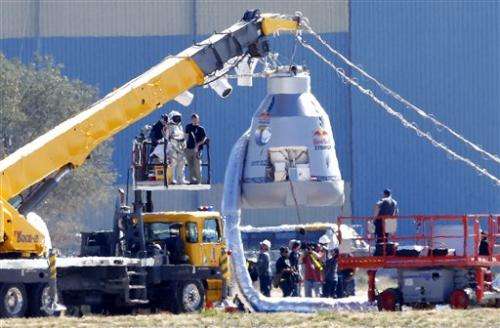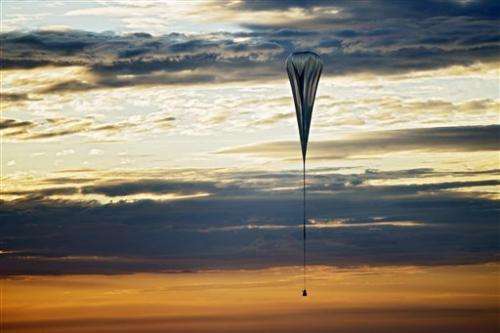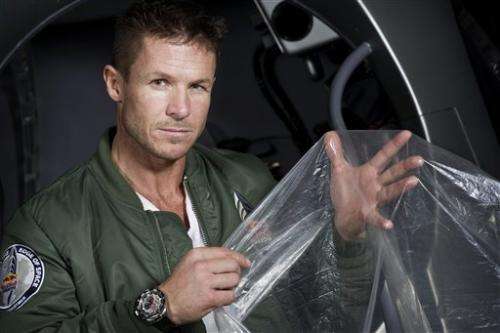Skydiver cancels try at supersonic jump

Extreme athlete Felix Baumgartner canceled his planned death-defying 23-mile (37.01-kilometer) free fall Tuesday because of high winds, the second time this week he was forced to postpone his quest to be the first supersonic skydiver.
The former military parachutist from Austria had planned to ride a pressurized capsule carried aloft by a 55-story, ultra-thin helium balloon into the stratosphere, and then jump in a specially designed suit.
But high winds led to the decision shortly after 11:30 a.m. to abort. Because the balloon is so delicate, it could only take flight if winds were 2 mph or below.
Baumgartner's team said he has a second balloon and intends to try again, possibly on Thursday.
The balloon had been scheduled to launch about 6:30 a.m. from a field near the airport in a flat dusty town that is best known for a rumored 1947 UFO landing. But high winds kept the mission in question for hours.
When winds died down, Baumgartner, 43, suited up and entered the capsule and crews began filling the balloon.
When winds died down, Baumgartner, 43, suited up and entered the capsule and crews began filling the balloon. But the team's discovery it had lost one of two radios in the capsule and a problem with the capsule led to delays in the decision to begin filling the balloon, pushing the mission critically close to a noon cutoff for launch.

As the balloon was finally filling, a gust of 25 mph (40 kph) whipped it around and could have damaged its integrity, mission technical director Art Thompson said. "Not knowing if the winds would continue or not, we made the decision to pull the plug," he said.
Mission meteorologist Don Day said, "it was just a situation where it took too long" and they lost their already pushed-back launch window.
Day was shown on a live video feed shaking his head as he watched the latest weather data just before the mission was halted. "I was very despondent because I could see the end right there," he said.
After sitting fully suited up in his capsule for nearly 45 minutes, Baumgartner was shown on a live video feed leaving the capsule and departing the launch site in his Airstream trailer.
Thompson said the earliest the team could try again would be Thursday because of weather and the need for the crew—which worked all night Monday into Tuesday—to get some rest.
Baumgartner was to make a nearly three-hour ascent to 120,000 feet (36,576 meters), then take a bunny-style hop from the capsule into a near-vacuum where there is barely any oxygen to begin what was expected to be the fastest, farthest free fall from the highest-ever manned balloon.
Among the risks: Any contact with the capsule on his exit could have torn the pressurized suit. A rip could have exposed him to a lack of oxygen and temperatures as low as 70 degrees below zero. It could have caused potentially lethal bubbles to form in his bodily fluids, a condition known as "boiling blood."
He could also have spun out of control, causing other risky problems.

The energy drink maker Red Bull, which is sponsoring the feat, had been promoting a live Internet stream of the event at www.redbullstratos.com/live from nearly 30 cameras on the capsule, the ground and a helicopter. But organizers said there will be a 20-second delay in their broadcast of footage in case of a tragic accident.
And while Baumgartner hopes to set four new world records when he jumps, his free fall is more than just a stunt.
His dive from the stratosphere should provide scientists with valuable information for next-generation spacesuits and techniques that could help astronauts survive accidents.
Jumping from more than three times the height of the average cruising altitude for jetliners, Baumgartner expects to hit a speed of 690 mph (1,110 kph) or more before he activates his parachute at 9,500 feet (2,895 meters) above sea level, or about 5,000 feet (1,524 meters) above the ground in southeastern New Mexico. The total jump should take about 10 minutes.
His medical director is Dr. Jonathan Clark, a NASA space shuttle crew surgeon who lost his wife, Laurel Clark, in the 2003 Columbia accident. No one knows what happens to a body when it breaks the sound barrier, Clark said.
"That is really the scientific essence of this mission," said Clark, who is dedicated to improving astronauts' chances of survival in a high-altitude disaster.
Clark told reporters Monday he expects Baumgartner's pressurized spacesuit to protect him from the shock waves of breaking the sound barrier. If all goes well and he survives the jump, NASA could certify a new generation of spacesuits for protecting astronauts and provide an escape option from spacecraft at 120,000 feet, he said.
Currently, spacesuits are certified to protect astronauts to 100,000 feet (30,480 meters), the level former Air Force Capt. Joe Kittinger reached in his 1960 free-fall record from 19.5 miles (31 kilometers). Kittinger's speed of 614 mph (988 kph) was just shy of breaking the sound barrier at that altitude.
Copyright 2012 The Associated Press. All rights reserved. This material may not be published, broadcast, rewritten or redistributed.




















